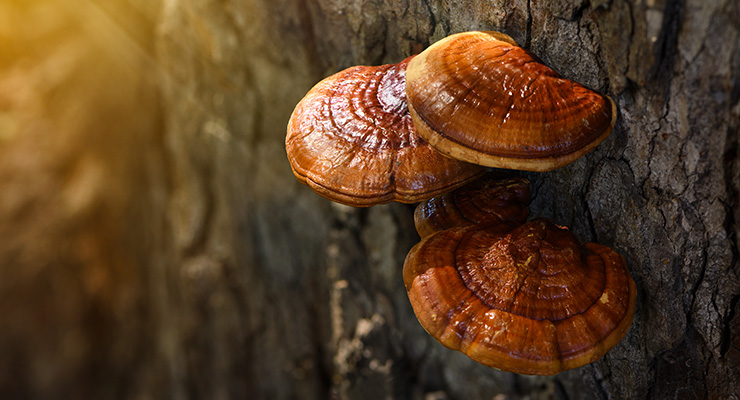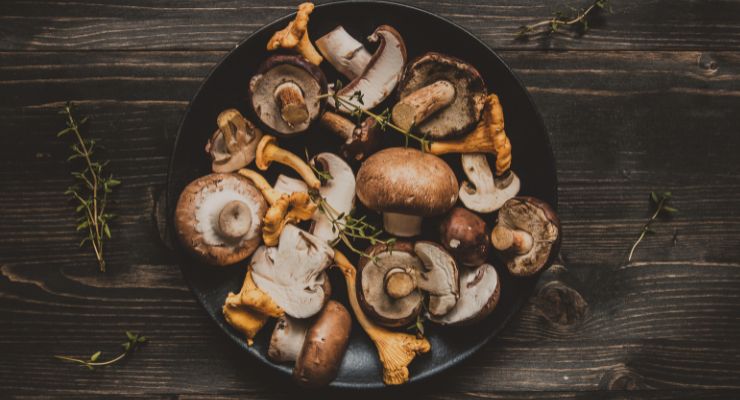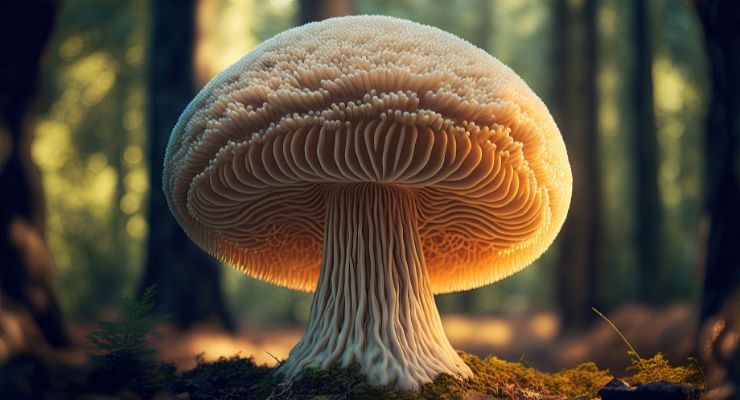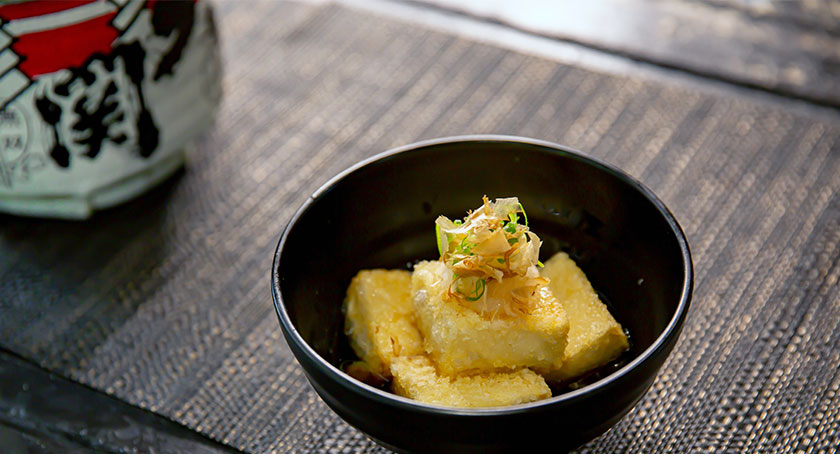Features
A Kingdom of Their Own: Fungi Shine While Mushrooms Emerge as Market Stars
The mushroom renaissance has led to diverse product development, as stakeholders construct a long runway for future innovation.

By: Sean Moloughney

A fascination with fungi has spread quickly throughout the U.S.—and for good reason. According to the U.S. Forest Service: “The fungus kingdom is enormous in its diversity, with over 100,000 described species. It includes yeasts, molds, rusts, and the familiar mushrooms. Fungi are the primary decomposers and recyclers of the planet, breaking down organic matter and returning it back to the soil where they are absorbed by organisms in the ecosystem, through mutualistic partnerships.”
Various species of mushrooms have been cropping up at farmers markets and restaurants while also starring in ready-to-drink teas, coffees, and other functional beverages, as well as a broad menu of dietary supplements.
Mushrooms have also seeped into popular culture, exemplified by HBO’s hit drama series “The Last of Us”—based on a video game of the same name—in which a “zombie fungus” (Ophiocordyceps unilateralis) overwhelms humanity in an apocalyptic plague.
If that doesn’t sound like your cup of tea, “The Super Mario Bros. Movie”—replete with its toadstool themes, characters, and imagery from the original videogame series—has raked in more than $1.2 billion globally, becoming one of the top animated movies of all time.
A Convergence of Market Drivers
Why are mushrooms seemingly everywhere, and in everything? They’ve certainly burst into the nutraceuticals market with voracity, as legacy mushroom companies experience a boom and broader brands extend product lines to meet consumer demand.“People are always looking for new ways to take better care of themselves,” noted Michael McGuffin, president of the American Herbal Products Association (AHPA). So all the attention given to fungi and mushrooms is a clear reflection of consumer interest in health-promoting natural products, he said.
The ongoing influence of Asian cuisine, expansion of the public’s palate, and recognition of the health benefits of mushrooms are all contributing factors, McGuffin suggested. “It’s no longer rare to find mushrooms in the grocery store, and I think that’s part of what has driven the growth of medicinal mushrooms in dietary supplements.”
Of course, COVID-19’s blunt-force-focus on immune health led many to investigate and discover the potential health benefits of mushrooms. “Reishi in particular is a leading adaptogen that supports the whole immune system, both innate and adaptive, with orally active beta-glucans and triterpenes,” noted Skye Chilton, COO of Nammex (North American Medicinal Mushroom Extracts), a leading supplier of certified organic mushroom extracts. Skye is the son of Jeff Chilton, a pioneer in growing, harvesting, and processing of medicinal mushrooms.
In fact, all mushrooms contain ergothioneine and ergosterol, compounds that have been investigated for their immune potentiation, Skye Chilton noted.
In many ways, immune health was “the gateway” for mushroom growth in the dietary supplement market, opening the door for other conditions. According to a recent Nutrition Business Journal (NBJ) consumer survey presented at AHPA’s 2023 Botanical Congress in May, 28% of people said general health concerns have led them to take mushroom supplements; 27% for mood and stress; 25% for brain health/cognition; and 22% for immunity.
These market drivers are all converging with a generational shift that is upending established cultural “norms” and challenging longstanding policies. For example, 69% of U.S. adults aged 18 to 24, prefer cannabis over alcohol, according to a survey by research firm New Frontier Data.
While marijuana (high-THC cannabis) remains a Schedule I substance under federal law, recreational use has been legalized in 22 states, three U.S. territories, and the District of Columbia. A vast majority of U.S. adults (88%) believe marijuana should be legal for medical and recreational use by adults (59%), or that it should be legal for medical use only (30%), according to a Pew Research Center survey from October 2022. Just 10% of people said they believe marijuana use should not be legal.

A Renaissance and Reawakening
The destigmatization of cannabis has also opened the doors of perception for other substances like psilocybin—a naturally occurring compound produced by more than 200 species of fungi, most notably mushrooms from the genus Psilocybe. Psilocybin is metabolized by the body into the psychedelic substance psilocin.In a survey of 5,000 consumers aged 21-23, Brightfield Group found that more than 10% reported having used psilocybin in the past six months, versus 3.4% for the general population.
In discussing fungi under the “Plants of Mind and Spirit” section of its website, the U.S. Forest Service noted: “Early in our history, people discovered the psychoactive properties in the fungus kingdom. Fungi, most notably mushrooms, have been used and revered as sacramental tools to communicate with the spiritual world by many cultures for thousands of years.”
“The oldest known petroglyph depicting the use of psychoactive mushrooms comes from the rock shelters at Tassili n’Ajjer on the southern edge of the Sahara desert in Algeria dating back to the Neolithic period. It is postulated that the mushrooms depicted on the ‘mushroom shaman’ are Psilocybe mushrooms.”
In 2018, author and journalist Michael Pollan—known for books like The Omnivore’s Dilemma: A Natural History of Four Meals and In Defense of Food: An Eater’s Manifesto—released a new book titled How to Change Your Mind: What the New Science of Psychedelics Teaches Us About Consciousness, Dying, Addiction, Depression, and Transcendence.
The book explores the history of psychedelics like psilocybin, LSD, Ayahuasca and 5-MeO-DMT, and discusses the renaissance of scientific research into their therapeutic potential.
Pollan’s work is helping to change minds about psychedelics, from something sinister and feared, to a category of therapeutics that should be revered for its medicinal value. Introducing the book on his website, Pollan wrote: “What began as a third-person journalistic inquiry ended up a first-person quest to learn what these medicines had to teach me about not only the mind but also my mind, and specifically about the nature of spiritual experience. This book has taken me places I’ve never been—indeed, places I didn’t know existed.”
Of course, Pollan isn’t the only “influencer” to advocate for psychedelic science.
Mycologist Paul Stamets, founder of Fungi Perfecti—makers of the Host Defense Mushrooms line of dietary supplements—has co-founded a new company in the psychedelic space called MycoMedica Life Sciences, whose mission is “unlocking the healing potential of the fungal genome for people and planet.”
Stamets has also founded a nonprofit called the Center for Ecological Consciousness (CEC), which according to Stamets is “a play on the ecology of consciousness and the consciousness of ecology.”
Supporting initiatives that help people “become more civil, responsible citizens of Earth, and create patterns that improve the quality of life for our descendants,” CEC is conceived to bring people from different disciplines together to create “new solutions to our agricultural and ecological challenges.”
Other advocates, among many more, include Dennis McKenna—brother of psychedelics proponent Terence McKenna—who is the director of ethnopharmacology at the Heffter Research Institute, which is focused on advancing studies on psilocybin for treatment of addictions and other mental disorders.
Conservationist Mark Plotkin is an ethnobotanist who has been studying the healing plants and shamans of the Amazon rainforest for about four decades. He hosts a podcast called “Plants of the Gods: Hallucinogens, Healing, Culture and Conservation.”
To be clear, the therapeutic application of psychedelics in controlled settings is a separate discussion from dietary supplements; but the scientific, academic, and social interest among respected thought leaders is helping spread a fascination with fungi.
“We’re not looking at (psychedelics) being available on the shelf next to elderberry,” noted Elan Sudberg, CEO of Alkemist Labs, who chairs AHPA’s Psychedelic Plants and Fungi Committee. “Clearly, the challenges in establishing this product category are significant, and include changes to legal and regulatory status, defining and designating quality, risk mitigation, developing and implementing technical specs, and access.”
AHPA has experience influencing marketplace growth in the cannabis market, he added, “advocating for best practices, and being an informed voice … We have the knowledge and experience to help guide the growth and development of this new category, as well as dedication to helping ensure it is done responsibly.”

Medicinal Mushroom Standards
In the dietary supplement market, mushrooms are at the leading edge of an overall strong marketplace of natural products.Past the immune-health gateway and into other health concerns, 25% of the general population—not just regular supplement users—indicated they currently use medicinal mushrooms, according to the Natural Marketing Institute. Primary uses are for energy, immune health, and general/overall health; secondary use has been for emotional health/stress reduction, and focus/memory improvement.
With a fast-growing market, that is distinct from Kingdom Plantae, experts have noted a need for education on fungi and mushrooms, as well as standardization.
“The market growth has outpaced validation of standard methods for evaluating” ingredients and products, said McGuffin.
As a result, AHPA has established a Mushroom and Fungi Subcommittee, under its Botanical Raw Materials Committee, which is assessing ingredient and product specifications and what scientifically valid methods are available.
“The short-term endpoint is to create a gap analysis that would identify top priorities for fungal standards development that can help inform AOAC International and USP,” said McGuffin. “Both of those organizations have recognized stakeholder needs in these categories.”
Various cultivation and production methodologies and different parts of the mushroom can influence the validity of test methods, as well, he noted; so there’s a real challenge for companies to identify or quantify constituents. “How do we develop or use analytical methods that can do that accurately?”
Sudberg said Alkemist Labs has been dealing with lack of standardization “since the beginning of our dawn,” and has developed test methods for the plants and fungi it tests. “There are others in this space that we communicate with regularly, advocating for best practices and test method clarity.”
According to Skye Chilton, the quality assurance department at Nammex is guided by “scientifically validated and commercially available testing methods that are practical, and provide a qualitative and quantitative measurement of known active compounds.”
In addition to the measurement of active constituents, “we also stay informed about adulterants and carrier materials that may be added to commercial products; identifying them is a critical aspect of quality control measures.”
In April, Fungi Perfecti reported discovery of unauthorized accounts on Amazon selling counterfeit products that imitate four products in its Host Defense Mushrooms line of supplements. During routine brand-control activity, the company investigated unauthorized sellers when it noticed inconsistencies in both packaging and capsule contents.
This discovery came about a week after NOW discovered 11 counterfeit products imitating its brand were being sold on Amazon. NOW said it found counterfeit vitamin supplements imitating another major brand as well.
Some of the counterfeit products Fungi Perfecti discovered tested positive for soy and gluten, allergens that authentic Host Defense Mushrooms do not contain. Like NOW, Fungi Perfecti said it’s working with Amazon to restrict all counterfeit sales imitating its products.
McGuffin commended NOW and Fungi Perfecti for identifying the problem, and noted that counterfeit products are not only a dietary supplement issue, but “a valuable goods issue.”
“Can the retailer be part of the solution? Will Amazon take steps to try to address this before a brand discovers it? I don’t know,” he said. “We are trying to improve our communications with Amazon in particular. It’s something that everybody has to pay attention to, unfortunately.”
At Nammex, the mushroom (sometimes called fruiting body) stage is used as the baseline for fingerprinting, “since the mushroom stage has been historically used in traditional medicine and upon which most medicinal mushroom research is based. The mushroom stage is also the DNA standard used for product identity.”
The medicinal mushroom constituents chosen for the Nammex QA program are β-(1–3)(1–6)-glucans, ergosterol and ergothioneine. Alpha-glucan analysis is utilized as a means of identifying starches, which are common carrier material, but not present in mushrooms themselves.
“Fungal polysaccharides, β-glucans specifically, are considered the foundation in the historical search for natural products that can potentiate and strengthen our immune systems,” said Chilton. “Because beta-glucans make up approximately 50% of the fungal cell wall they provide an important metric of medicinal mushroom activity as well as the actual presence of fungal matter in a product. Fungi also contain alpha-glucans in the form of glycogen as their storage carbohydrate, as opposed to plants, which store them as starch.”
Testing of fungi is not much different than botanicals, according to Sudberg. “We perform identity testing using HPTLC and microscopy; we measure fungal chemicals using LC and LCMS; and we make sure it’s within the legal limits of contaminants like pesticides, heavy metals, residual solvents, and microbials. Like any other fast-moving category, fungi have their own list of usual suspects we look for, including but not limited to other species, incorrect parts (mycelium vs. fruiting body), and the various fillers like starch and abundant grain from substrates.”

Glossary of Terms Relevant to Fungal ingredients
(From the American Herbal Products Association’s Guidance Policy on Labeling of Dietary Supplements Containing Fungi Dietary Ingredients)- Hypha: One unit of the filamentous structure of a fungus which together make up the mycelium. Plural form “hyphae.”
- Fruitbody: The fleshy reproductive stage, primarily composed of hyphae, that produces spores and provides a mechanism for their dispersion. Alternative forms are “fruit body” and “fruiting body.”
- Mushroom: When used as a noun may be used as a synonym for “fruitbody” as defined here; when used as an adjective or descriptor, “mushroom” may be used to indicate an association with a multicellular species in the Kingdom Fungi (e.g., “mushroom mycelium”).
- Mycelium: The vegetative portion of a fungus composed of a mass of hyphae. Plural form “mycelia.”
- Primordium: The first recognizable but undifferentiated mass of hyphae from which the fruitbody develops. Plural form “primordia.”
- Sclerotium: A compact aggregate of hyphae. Plural form “sclerotia.”
- Spore: The survival or dispersal reproductive unit that is capable of germinating to produce a new hypha.
- Substrate: The surface or material on or from which a fungus lives, grows, or obtains its nourishment.
Terms and Conditions
Covering some basics, Bill Chioffi, chief strategy officer at Nammex, offered a 101 crash-course on mushroom growing and terminology.“Strictly speaking, the mushroom is the aboveground portion of a fungal organism,” and is sometimes referred to as a fruit body or a fruiting body. “What you don’t see of that fungal organism is the mycelium,” a vegetative mass, or network, composed of hyphae, which are fine, thread-like, filamentous structures. Mycelium can be produced from a spore, or a piece of mushroom that can be cultured to grow this network of hyphae within and around a food source, like woody debris, dead plants, leaves, soils, and grasses.
“Mycelium secretes enzymes that break down the organic materials into smaller, water-soluble units that can be absorbed into the cell walls of the mycelium for growth,” Chioffi explained. “That absorption of nutrients will allow the network to grow and spread in all kinds of different directions throughout the whole structure of whatever it’s devouring, and form the vegetative body of the fungus.”
Under suitable conditions, “that mycelium network of filament threads will come together into primordia,” the first recognizable but undifferentiated mass or aggregation of hyphae, “and then eventually develop into what people recognize as a formed mushroom—also known as a fruitbody or a fruiting body that produces spores,” Chioffi said. “It happens pretty quickly. I love the time-lapse videos that are available to see these (form).”
In terms of production, harvesting, and application in finished products, as Sudberg put it: “There are three major camps: those who swear by mycelial mass, those who swear by the fruiting body, and those who don’t know the difference.”
The debate about fruiting bodies vs. mycelium has more to do with how some mycelium is grown, or more precisely, what substrate it’s grown on. “Oftentimes (mycelium) are grown on a solid grain-substrate like oats, rice, or some other grain that they, the mycelium, will digest,” said Chioffi. “It’s important to note that the process of growing commercial mushrooms for consumption, like a white button Agaricus mushroom, does not happen on grain. It happens on compost, or straw, or other materials.”
Chioffi said mycelium grown on grain, or what’s called “grain spawn,” doesn’t completely digest the substrate. Often the product that’s left is mostly still grain the mycelium was grown on, sometimes referred to as “myceliated grain.” This can be shown in a simple starch test since mushrooms do not contain starch.
Grain spawn can be used to “seed” another growing medium, but Chioffi said that’s not typical in today’s market.
Mycelium is necessary, he said. “It’s one of the greatest regenerators of material in the natural world. It’s really the fact that the grain is oftentimes, I think, not accounted for well … I’d love to see more quantification of how that grain has been transformed into something different.”
From a regulatory standpoint, in Europe, mycelium grown on grain is classified as a Novel Food, which would require filing a safety dossier.
In the U.S., in terms of labeling dietary supplements containing fungal ingredients, AHPA’s guidance encourages companies to identify whether the ingredients in their products are, for example, fruiting bodies or mycelium.
“Whatever part you’re using, whatever life stage you’re using, we think customers want to know that,” said McGuffin. “We understand that in the vernacular ‘mushroom’ has two meanings. It means this whole collection of life forms that might be better described as fungi, but in our minds, it also means that fruiting body … So we wanted to clarify that by saying that if you’re using mycelium, that needs to be blatantly disclosed, including on the principal display panel.”
Able to process multiple tons of extracts regularly and consistently at scale, Nammex grows its mushrooms on natural wood substrates in China. As the category continues to grow so rapidly, Chilton said Nammex expects proper labeling of material is going to become a sticking point with FDA. “The industry should focus on getting the identity of a fungus part correct on their labels before they get a warning letter,” he said.
Sempera Organics has taken a different approach to mushroom growing and processing standardized functional mushroom powders, blends, and extracts at its “clean, vertical, lab farm” in the San Francisco Bay area, which recently gained SQF and cGMP certification.
Founded by entrepreneur and engineer Nirmal Nair, Sempera utilizes a zero-waste manufacturing process and consumes low amounts of energy to produce approximately 70 tons of finished ingredients annually, including more than 25 mushroom species that are USDA-certified organic.
“We looked at every aspect of the processing pipeline, from first principles. I’m not from this industry so I didn’t have any preconceived notions coming in. We developed what I think is next generation technology that lets us grow high-quality mushroom ingredients, both fruiting bodies and mycelium, in disposable bioreactors in a way that’s highly sustainable.”
Nair said the company monitors every stage of growth to produce material as quickly as possible while reaching specific target levels for bioactives.
“We are exploring the substrates that mushrooms can grow on,” said Nair. “Mushrooms are natural decomposers. They can take complex carbon forms and break them into simpler forms and use that to grow. They can also feed themselves on what could be considered side streams, or waste from other food industries that’s still good organic matter.”
Nair said the company’s technology allows for bringing in other substrates, “which we’ll explore over time, as long as it hits the marks of being safe and provides a way to reduce waste. We are strong believers in a circular economy. Being zero-waste at our facility is one thing, but being able to use something that would otherwise go to waste is a good opportunity for us.”

The Shroom Horizon
Swimming in a sea of opportunity for medicinal mushrooms, which varieties are making waves?Enter the term Ganoderma (the genus of the mushroom Reishi) in the National Institutes of Health, National Library of Medicine database PubMed and 3,259 results return, while the same search for Hericium (Lions Mane) yields 474 results, said Chilton.
“While both are popular, Reishi has been in commerce much longer and has also been the focus of much more worldwide research. Interestingly, Lion’s Mane (Hericium erinaceus) is currently one of our top sellers.”
With its long history in Traditional Chinese Medicine, Reishi will likely continue to be prominent, McGuffin suggested. “I see Lion’s Mane showing up a lot,” he added, “not just in supplements but also in foods. That one seems to have struck a chord of significant interest.”
Chaga, traditionally consumed as a tea, isn’t actually a mushroom. It’s a fungus (Inonotus obliquus) that manifests as an infection in trees as a hardened mass or canker that can last for years, said Chioffi.
Known for its beta-glucans and cordycepin, Cordyceps militaris has similar active compounds and activities to Ophiocordyceps sinensis. Although Chioffi said Cordyceps is the only species Nammex grows on organic grain (rice), instead of wood and uses only the mushroom for its extracts.
Consumers are also getting more familiar with varieties like turkey tail, shiitake, maitake, king oyster, and many others.
“Mushrooms have been consumed primarily as foods for centuries and lend their use to food presentations as well as traditional dietary supplement deliveries such as capsules and drink mixes for those who don’t like the taste of mushrooms,” said Chilton. “We’ve seen our ingredients in everything from frozen confections to tea bags. We credit the innovative brands and partners we work with for continuing to find new ways to introduce consumers to the benefits of mushrooms.”
For the supplement industry, Sudberg predicted the category of medicinal mushrooms will grow faster than herbs/botanicals. “They live on decomposing plant matter, use fewer resources to grow than plants, and have fewer issues with pesticides and heavy metals than plants. Being there are only around 130 species of medicinal mushrooms vs. the nearly 2,000 medicinal plants we test, I don’t foresee the category surpassing plants, but it will remain a remarkable size of the industry. We’re certainly testing more mushrooms.”
In the food category, Sudberg said he’s looking forward to the application of mushrooms as meat alternatives (products like Mamu, which is made from mushrooms and chickpeas).




















